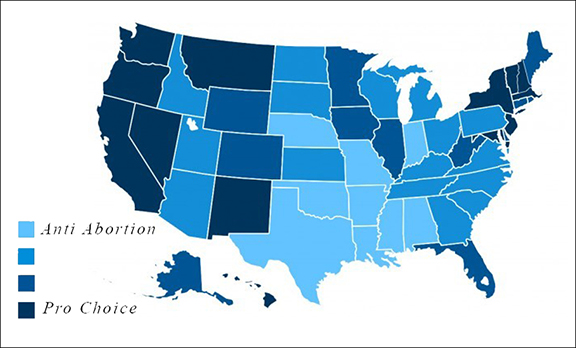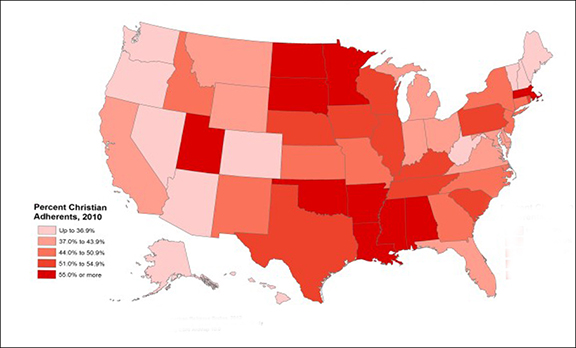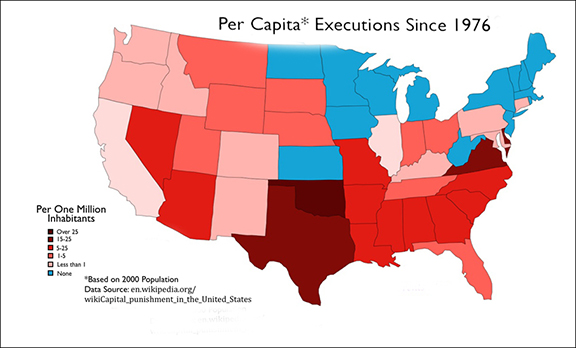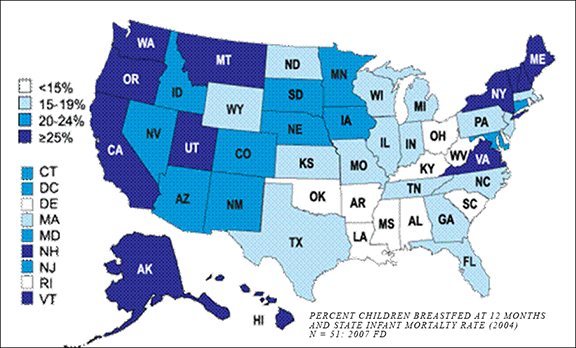
One must wonder why the ‘abortion is murder,’ slogan is in the air. On Friday, May 4th, Iowa Governor, Kim Reynolds (R), who has referred to abortion as “murder,” signed the country’s most restrictive abortion bill into law, outlawing the procedure once a “heartbeat” is detected, which is usually at about six weeks — a time when many people do not yet know they are pregnant.

Given the moral failure of the current administration, taking the high-ground, implicit in the forced reexamination of Roe vs. Wade is a neat strategy. Why? The underlying assumptions are so entrenched, personal and reflexive – and therefore polarized – it renders this moral-ethical distraction a perfect rally to gather support from the base.
It is important to note that the clock is ticking on this thorny issue. Professor Carl Djerassi, an Austrian-born Bulgarian-American chemist, novelist, and playwright, best known for his contribution to the development of oral contraceptive pill claims that advances in fertility treatment may soon render sex purely recreational with large numbers of babies in the Western world born through IVF. He believes the Pill and abortion will become obsolete. Men and women will choose to freeze their eggs and sperm when young, before being sterilized. No child will be unplanned or unwanted. End of controversy. But what about today?
abort
[verb \ ə-ˈbȯrt]
To terminate a procedure prematurely
abortion
[ə-bôrˈshən]
The ending of pregnancy by removing an embryo or fetus before it can survive outside the uterus. An abortion that occurs spontaneously is known as a miscarriage. An abortion may be caused purposely and is then called an induced abortion, or less frequently, “induced miscarriage”. The word abortion is often used to mean only induced abortions. Is abortion murder?
murder
[mur-der]
The unlawful killing of another human without justification or valid excuse or killing a person with premeditated malice.
malice
[mal-is]
The desire to inflict injury, harm, or suffering on another, either because of a hostile impulse or out of deep-seated meanness: The intent to commit an unlawful act or cause harm without legal justification or excuse
Implicit in the question; ‘is abortion murder,’ are a number of troubling assumptions.
- At which point does a living organism, egg, embryo, become human?
- What defines being human?
- Is a human life different from the life of other mammals, other life forms which means that taking a human life is fundamentally different from taking the life of closely related species?
- Lawful and legal are implicit in the allegation ‘abortion is murder.’ Whose law? By what authority and when, especially when it comes to the sovereignty of a woman’s body?
- When did this assumed authority to dictate and control a woman’s body begin? Do we agree that forced control of ideology over the body is appropriate? If we disagree, by what authority does one group justify forcing their belief on another?
- When it comes to pregnancy is this forced control of what a woman (or man) may or may not do within his or her own body a form of slavery?
There are, of course, other questions.
Here we have quite a number of complex definitions to unwind; what is human, when does the soul, presumably a human soul, inhabit an otherwise sentient lifeform, a fertilized human egg? Is sentient equal to having a soul? Amoebas, chickens and tadpoles are sentient. All life, for that matter, is sentient. Do flees, ants, trees and slime mold have a soul? What distinguishes a human soul from the soul of a blade of grass or a cow chewing on that grass? Is that cow’s chewing murder?
It has been said that the capacity to use symbols, metaphors and create abstract concepts is the defining capacity that distinguishes human from chimpanzees and other mammals, not to mention snakes, flees, bats and strawberries. When does this symbolic-metaphoric-conceptual capacity develop? How fully must this potential be developed before the soul inhabits? Is the soul somehow an extension of this abstracting capacity? Is this the line that defines human from protoplasm? Is the premature termination of the process that begins at conception – before this humanizing abstracting takes place –murder?
Notice that ‘lawful’ or ‘legal’ are integral components that define both murder and malice. Whose laws; biblical, presumably the will of God, or man-made laws, the church, which church or state, federal, international, and when? As Jim Prescott notes, a Pope in 1869 flipped the law reversing centuries of precedent. Does that mean all the abortions prior were murder? When does ‘law’ supersede sovereignty over one’s body?
Writes James W. Prescott, PhD:
That abortion is murder is a belief not shared by the Catholic Church which taught for Centuries the doctrine of delated hominization that it was unknown and unknowable when the human rational soul was infused into fetal life which led St. Augustine and St Thomas Aquinas to affirm that “Abortion, if early is not homicide.”
Pope Pius IX in 1869 rejected centuries of church doctrine of delayed hominization and compelled the adoption of the unsupportable doctrine of immediate hominization (ensoulment at conception.). The battle lines are drawn: St Augustine and St. Thomas Aquinas vs Pius IX and his betrayal of established Catholic doctrine.
The law does not provide that the act (abortion) pertains to homicide, for there cannot yet be said to be a live soul in a body that lacks sensation when it is not formed in flesh and is not endowed with sense – St Augustine. (In. Jane Hurst (1983). The History of Abortion in the Catholic Church” The Untold Story. Catholics for a Free Choice. Washington, DC. See Flower: Neuromaturation and the Moral Status of Human Fetal Life, attached.
Laws are fickle, far from absolute. In 1982 the Justice Department tried to determine the total number of criminal laws, a project that lasted two years. The Department compiled a list of approximately 3,000 criminal offenses. From a Wall Street Journal article, “this effort came as part of a long and ultimately failed campaign to persuade Congress to revise the criminal code, which by the 1980s was scattered among 50 titles and 23,000 pages of federal laws.” The author characterized this fruitless project: “You will have died and [been] resurrected three times,” and still not have an answer to this question. So, our challenge; ‘is abortion murder,’ is not as cut and dry as it seems.
Islamic Jihadists abide to laws that are different from the Catholic church or Fundamental Christians. For Jihadist and, as we will see, many staunch Christians, torturing, killing, genocide, raping and forcing nine and ten-year-old girls into sex slavery was supported. Hindus and Buddhists have their own codes of ethics. Is law, church or nation the reason why this issue is so polarized? Is the logic used to support the claim that ‘abortion is murder,’ consistent? Or is Pro-life intentionally misleading, like Peacekeeper missiles, the Patriot Act and Federal Reserve. Personally, this question, ‘is abortion murder,’ is like wrestling with a slippery pig. Every position is a trap door that springs open.
Assumption: Each human life is sacred. Willfully terminating that life is a crime against humanity and against God’s nature, will or law.
Question: Human beings are mammals. Is the life of every mammal, all God’s creations, not equally sacred? Or, are we special? Really? In what way?
Approximately 20 billion sea animals were killed (by the US) for human consumption in 2009. Ten billion cattle, chickens, ducks, hogs, sheep, lambs and turkeys were killed for food in the United States in 2015. Worldwide animals killed for Americans’ food are about 8.3 billion land animals and 51 billion sea animals, a whopping 59 billion animals each year. Are these homicides?
Sentience is defined as the capacity to feel, perceive or experience subjectively. Bacteria sense and respond to the environment, a form of sentient feeling, so do lizards, bats, bunnies and the neighbor’s cat. Does this feeling-responsiveness mean that bacteria, each microscopic individual, has a soul? Or, is it the capacity to think, to have ideas and form concepts, perhaps most importantly the concept of having a soul, that define soul-ness? And is soul-ness the defining quality that defines and separates being human from the chickens and cows we murder and eat? We human beings are evolved mammals. Are we really that different from other mammals? Is killing our cousin, a chicken for lunch, murder?
Assumption: Sometimes murder isn’t murder. In 1863 at the Battle of Gettysburg, over 50,000 boys and men were slaughtered between July 1st and 3rd. At the beginning of World War I, 20,000 British soldiers lost their lives in just over an hour in the trenches during the first battle of Ypres. 900 French and 1300 German soldiers were killed each day.
Question: Were these and all other politically motivated deaths murder?
Murder [mur-der]
The [unlawful] killing of another human without justification or valid excuse or killing a person with premeditated malice. Each side in a conflict clearly feels justified.
We celebrate Columbus Day in the United States, which is historically quite strange. The King and Queen of Spain sent Christopher Columbus hunting. Howard Zinn writes:
Arawak men and women (natives), naked, tawny, and full of wonder, emerged from their villages onto the island’s beaches and swam out to get a closer look at the strange big boat. When Columbus and his sailors came ashore, carrying swords, the Arawaks ran to greet them, brought them food, water, gifts. Columbus later wrote of this in his log:
They brought us parrots and balls of cotton and spears and many other things, which they exchanged for the glass beads and hawks’ bells. They willingly traded everything they owned… They do not bear arms, and do not know them, for I showed them a sword, they took it by the edge and cut themselves out of ignorance. They would make fine servants… with fifty men we could subjugate them all and make them do whatever we want.
The Indians, Columbus reported, “are so naive and so free with their possessions that no one who has not witnessed them would believe it. When you ask for something they have, they never say no. To the contrary, they offer to share with anyone…
In the year 1495, Columbus went on a great slave raid, rounding up 1,500 Arawak men, women, and children. He put them in pens guarded by Spaniards and dogs, then picked the 500 best specimens to load onto ships. Of those 500, 200 died in route. Murder?
The chief source — and, on many matters the only source — of information about what happened on the islands after Columbus came is Bartolome de las Casas, a young priest who participated in the conquest of Cuba. When he arrived on Hispaniola in 1508, Las Casas says: “There were 60,000 people living on this island, including the Indians. While I was in Cuba, 7000 children died in three months. Some mothers even drowned their babies from sheer desperation…. In this way, husbands died in the mines, wives died at work, and children died from lack of milk . . . and in a short time this land which was so great, so powerful and fertile … was depopulated….From 1494 to 1508, over three million people had perished from war, slavery, and the mines. Who in future generations will believe this? I myself writing it as a knowledgeable eyewitness can hardly believe it…” Murder? History notes: what Columbus did to island natives Cortes did in Mexico and white settlers did to American Indians.
Reaching back from the future; what about today? The Atlantic parted ways with Kevin Williamson, a conservative writer for his statement: Women who have abortions are murderers and, therefore, should be hanged [“An offensive but honest stand on abortion,” op-ed, April 8].
The brain is the biological organ of “personhood… the brain is the only organ that we cannot live without or replace from somebody else or have a substitute for. The brain is the real seat of personhood. You cannot ever have a person without a brain. You have persons without hearts, livers, kidneys, etc. (artificial organ replacement or loss of a non-vital organ) but not without a brain. Thus, in any discussion of “personhood” from a biological perspective it is essential and mandatory to include the brain.”
(Neuromaturation of fetal brain: No neocortical synapses are seen earlier than 19 weeks of gestation. Beginning at perhaps 21 to 23 weeks of gestation there is a transition to a neocortex potentially in receipt of sensory input. The maturity of this interconnection is not realized until after about 28 weeks of gestation at which time the emergence of “Personhood” can be expected.)
James W. Prescott, PhD
On the one hand we murder tens of thousands of men, women and children for profit each year beneath the shadowy flag of patriotism. War, after all, is mass murder, rationalized and therefore made acceptable by one ideology of another, nearly always for profit. We murder based on race, on religious differenced, and any number of concepts that appeal. All this is perfectly acceptable and officially encouraged. And then, those who generally support the use of pain and violence imposed on those who don’t conform (see below) point the accusing finger at individual females facing arguably the most difficult challenge of their life; given my state of heart, mind and body, my resources and ability; is it appropriate to invite, nurture, model, mentor, support and mother a new human being at this very moment?
Do anti-abortionists support and approve of the death penalty? Do they not spare the rod and therefore not spoil the child by approving and practicing corporal punishment, spanking, beating and other forms of physical punishments for childhood misbehavior, according to their belief system? Are the anti-abortionist pro-life when it comes to war or hawkish and patriotic when it comes to mass killing?
As you will see below, the logic on these issues gets rather mixed. Is, perhaps, the real issue not respect and compassion for life but another motive lurking behind the banter? Is the true goal of the anti-abortion crusade, like the Spanish Inquisition and Jihadist revolt, retaliation against those who do not conform to the anointed belief system? If this were not the case, the dramatic contradictions, in a word, the implicit hypocrisy, would not be so apparent.
Hypocrisy is the contrivance of a false appearance of virtue or goodness, while concealing real character or inclinations, especially with respect to religious and moral beliefs. Hypocrisy is often the practice of engaging in the same behavior or activity for which one criticizes another. Let’s have a look.





Seeing this persistent pattern one asks, when did this passionate crusade to control women’s bodies, which is the real issue, the patriarchal dominance of abstracted intellect, power and control over nature and the body, begin? Some suggest as early as CA 970-931 with the authors of the biblical creation stories and the mythology of Eden. The Eden story describes an unprecedented transition from Paganism where nature herself was sacred, the Goddess, to a judging, vengeful abstracted God in the Sky who had to rape, subjugate, humiliate and push aside the Goddess in order to rip the throne from under her and claim it for himself. Once this grab for power, prediction and control began, the battles, in virtually infinite forms, continue to this day. (See: The Mythology of Eden, Arthur and Elena George, Hamilton Books, copyright 2014 https://www.amazon.com/Mythology-Eden-Arthur-George/dp/0761862889)
When does the state, institution or belief system acquire the right and obligation to dictate what a woman (or man) does with his or her body? Spain answered this question in 1478–1834, with 350 years of terror. Established by papal decree, the first task of the Spanish Inquisition was to question Jewish converts to Christianity and expose and execute those found guilty of reversion, reversion being the act or process of returning to a former condition, not obeying what the state or belief system insists they believe. Authorities then turned on Spanish Jews, sending 300,000 into exile. Next in were humanists and Lutherans.
Children informed on their parents, merchants on their rivals, and priests upon their bishops. Those denounced were guilty unless they could prove their innocence. Nearly 32,000 people were publicly burned at the stake, flogged, fined, or imprisoned. Is this really different from ‘abortion is murder?’
The fall or original sin that elicits and empowers this violence, pain and abuse of others is, and has been, reification; mistaking abstract concepts and images created by the neocortical regions of the brain for concrete independent realities. The self-image, what we call our personal ego, and the collective ego we call culture are fabricated from these images. Once the image is assumed to be an independent reality it quickly assumes supreme importance. Similar images, such as belief systems, are fused into this identity. Challenging a strongly held belief is felt and treated as a threat to one’s personal identity, thus laying the foundation for Jihadists, regardless of their faith.
Increasingly human attention has been drawn into, enchanted, and empowered by our identification with these neocortical images – and the relative reality they often imply. This pervasive flaw was described centuries ago by the Christian mystics St John of the Cross and Meister Eckhart and in contemporary terms by J. Krishnamurti. “The word is not the thing. The images thought creates about what is called sacred, are not sacred.” St John of the Cross put it this way: “If I have my hands over my eyes I cannot see the sun. If I have an image of God, I cannot see God.” Like the social ego, all organized religions and political systems are based on mental images.
Fortunately, not all who follow the teaching of Christ, Judaism, Islam or Buddhism support the position being forced by anti-abortion, often Christian Jihadists.
Michael Mendizza with James W. Prescott, PhD.
Catholics for Choice
March 27, 2018
U.S. Department of Health and Human Services
Office of Civil Rights
Attn: Conscience NPRIM, RIN 0945-ZA03
Hubert H. Humphrey Building, Room 509F
200 Independence Ave., SW
Washington, DC 20201,
VIA Regulations.gov
RE: Department of Health and Human Services, Office of Civil Rights
RIN 0945-ZA03
Dear Director Severino:
On behalf of the majority of the more than 70 million Catholics in the United States, who as a matter of conscience, disagree with the Catholic hierarchy on issues related to reproductive health and rights, we submit this public comment to express our deep concern regarding the new regulation that the Department of Health & Human Services (“HHS ” or “the Department ”) has proposed, which expands the scope and reach of religious exemptions in HHS programs and activities under the auspices of the new Division of the Office of Civil Rights.
Catholics for Choice is an international nongovernment organization that shapes and advances sexual and reproductive health ethics that are based on justice and reflect a commitment to wellbeing for all individuals. We represent the lived reality of everyday Catholics and offer our expertise, rooted in the foundational Catholic teaching that every individual must follow his or her own conscience and respect others’ right to do the same.
Our Catholic tradition requires us to respect conscience-based decisions, advocate for the poor and marginalized and respect pluralism and religious freedom. We firmly believe that HHS should advance policies and regulations that promote principles of social justice, protect moral autonomy for every individual and ensure true religious liberty for all in matters of healthcare and other public social service provision…
American Jewish Congress
November 5, 1981.
Dear Friends,
Did you know that abortion can be a religious requirement? Not just permitted, but required? In some religious traditions, if the fetus endangers the life of the mother, abortion is not a matter of choice; it is mandatory! The conflict over abortion is not between “secularists” and “religionists,” between “moral” people who value life and “immoral” people who do not, but between different moral traditions, different understandings of the sacredness of life.
According to some religious traditions, the sacredness of life can be diminished far more by callousness to those already born than to the un- born, however precious their promise. These religious traditions believe that the sacredness of life requires in some circumstances that the woman’s well-being takes precedence over of the fetus. Legislation that denies a woman’s choice is objectionable not because it limits some abstract notion of unrestrained freedom, but because it may inflict irreparable damage to the human dignity of the woman who is carrying the fetus.
Judaism affirms that nascent life has great value. But it is not the only value. In the face of the kind of desperation that drives women to risk their lives and mutilate their bodies rather than carry the fetus to term, no one has the right to say that other conflicting values do not exist. When faced with such conflicting values, individuals should be able to turn to their own moral traditions or religious faith for guidance. Government has no business preempting that very personal process, leaving women trapped without a choice.
We do not propose that a particular religious view of abortion find expression in legislation. That would be violating someone else’s religious freedom. And many people’s moral choices regarding abortion are deeply personal, and not determined by any particular religious’ tradition. In the face of such great moral and religious diversity, the proper role of government in a free society is to allow different traditions to advocate their respective views, and to leave the decision to the woman, answering to God and to her conscience.
This Open Letter has been drawn from testimony presented by the Executive Director of the American Jewish Congress, before the Senate Judiciary Committee on November 5, 1981.
Abortion and the Legislation of Religion
James W. Prescott, Ph.D.: Abortion or the Unwanted Child: A Choice For A Humanistic Society.(link is external)
Advancing the thesis that abortion denied equals compulsory motherhood and the birth of unwanted children who become the populations for future social alienation, crime, violence and failure to love. The Humanist, March/April 1975 (last modified ).
James W. Prescott, Ph.D. (1978): Abortion and the “Right-to-Life”: facts, fallacies, and fraud.(link is external)
In: The Humanist July/August (last modified )
James W. Prescott, Ph.D. and Douglas Wallace, Ph.D. (1978): Abortion and the “Right-to-Life”: facts, fallacies, and fraud. II. Psychometric Studies. (link is external)In: The Humanist Nov/Dec. pp 36-42. (last modified )
James W. Prescott: The Abortion of The Silent Scream(link is external)
A study on the relationship between anti-choice and anti-life/pro-pain attitudes. Published in The Humanist, September/October 1986. (last modified ).
James W. Prescott, Ph.D. (1989): Personality Profiles of ‘Pro-Choice’ ad ‘Anti-Choice’ Individuals and Cultures.(link is external)
In: Abortion Rights and Fetal ‘Personhood’ (Edd Doerr and James W. Prescott, Eds.) Americans For Religious Liberty. Silver Spring, MD. (last modified )
Michael J. Flower, Ph.D. (1989): Neuromaturation and the Moral Status of Human Fetal Life.(link is external)
In: Abortion Rights and Fetal ‘Personhood’ (Edd Doerr and James W. Prescott, Eds.) Americans For Religious Liberty. Silver Spring, MD. (last modified )
American Jewish Congress: An Open Letter To Those Who Would Ban Abortion.(link is external)
Published as a full-page advertisement in The New York Times, February 28, 1989. PDF format (last modified ).
Barbara Honegger (1989): A Proposed “Bodily Sovereignty” Amendment To The U.S. Constitution.(link is external)
The Truth Seeker. May/June and statements by leading feminists, Abigail (Smith) Adams, Elizabeth Cady Stanton, Susan B. Anthony and Margaret Sanger in defense of women’s Constitutional rights to control her own body. (last modified )
Judge J. Flaherty (1978). In The Court of Common Pleas of Allegheny County, Pennsylvania. Civil Division. McFall v Shimp. (link is external)The Truth Seeker. May/June. File contains opinion and additional commentary by James W. Prescott, Ph.D. (last modified )
James W. Prescott, Ph.D. and Edd Doerr: Fetal Personhood: Is An Acorn An Oak Tree?(link is external)
The Truth Seeker, May/June 1989, pp. 15-28 (last modified ).
Bishop Leo T. Maher: Letter to Assemblywoman Lucy Killea(link is external)
November 15 1989 anti-abortion letter. Published in The Truth Seeker, November/December 1989, p. 32. JPG Image (last modified ). For a PDF Version Click HERE. (link is external)(last modified )
James W. Prescott, Ph.D., et. al.: Bishop Maher Felony(link is external)
An article by Prescott and a series of letters, written from January to June 1990, between Prescott (and Attorney Rita Risser) and Edwin L. Miller, Jr.; John Van de Kamp; and Steven J. Casey in response to Maher’s letter. Published in The Truth Seeker, Summer 1990, pp. 43-48. PDF format (last modified ).
James W. Prescott, Ph.D.: Violence Against Women(link is external)
Philosophical and Religious Foundations of Gender Morality. New Perspectives, 3/4 1995, pp.16-18 (modified ).
Letter from Hillary Rodham Clinton (The White House) of 4 March 1996 to Dr. James W. Prescott, which acknowledged his letter with attachments on the crises of mothers and children in America. This form letter gives no information on the subject matter of the letter. What “lasting change” does she have in mind? Click HERE.(link is external) (last modified )
Letter from Rev. William G. Sinkford, President, Unitarian Universalist Association of July 7, 2004 to Dr. James W. Prescott that declined to take action in opposing the legislation of religious belief that creates a theology of fetal personhood. Click HERE.(link is external) (last modified )
Letter from Rev Richard S. Gilbert, Interim Minister, First Unitarian Church, Ithaca, NY of 4 February 2005 to Senator Hillary Rodham Clinton requesting support for the Petition to Congress for legislation that would nullify the “Unborn Victims of Violence Act of 2004 (H.R. 1997). Click HERE.(link is external) (last modified )
Galileo: Forced Testimony by The Inquisition(link is external)
1633 statement that subordinated scientific truth to religious dogma, with 2004 commentary on the Unborn Victims of Violence Act. Word format (last modified ).
James W. Prescott, Ph.D.: Must Violence, Religion Go Hand in Hand?(link is external)
March 6 2004 review of Mel Gibson’s film, The Passion of the Christ, The Ithaca Journal. (last modified).
UUA: Unitarian Universalist 1982 General Assembly Resolution(link is external)
that rejects a theology of fetal personhood. Word format (last modified ).
Congressional Letter to Cardinal McCarrick from Catholic legislators(link is external)
May 10 2004 letter concerning the abortion issue and separation of church and state. PDF(last modified ).
James W. Prescott, Ph.D.: Fetal Personhood(link is external)
January 13 2005 letter published by The Ithaca Journal. (last modified )
Rev. Richard S. Gilbert (2005). Letter to Senator Hillary Clinton with Petition to the Congress February 4, 2005. http://unitarian.ithaca.ny.us/SJC/RSGLetter20050204.html(link is external)
James W. Prescott, Ph.D.: Letter to Senator Diane Feinstein(link is external)
July 20 2005 letter apprizing her of the “Petition to the Congress” submitted by the First Unitarian Church, Ithaca, New York, which has requested that the Congress initiate legislation to nullify the “Unborn Victims of Violence Act 2004” and to affirm the principles of separation of church and state and the rights of women to be free from compulsory motherhood (abortion denied). (last modified ).
Rev. Richard S. Gilbert and Martha Ferger: Petition to Senator Hillary Clinton(link is external)
January 23 2005 “Petition to the Congress” to nullify the “Unborn Victims of Violence Act 2004” (H.R. 1997). Petitions were also sent to Senator Schumer, Congressmen Hinchey and Boehlert. (These petitions are not posted as they are identical to the Clinton one). (last modified )
Senator Hillary Clinton: Response to the “Petition to the Congress”(link is external)
February 11 2005 response by Senator Clinton to the above communication by Rev. Richard Gilbert. (last modified )
James W. Prescott, Ph.D.: Letter to Senator Hillary Clinton(link is external)
March 22 2005 reply by Dr. Prescott to Senator Clinton’s letter of reply which consisted of her dated form letter that referred to H.R. 1997 before it had come to the Senate. A more complete history of these events(link is external) is available at the website of the First Unitarian Society of Ithaca(link is external)’s Social Justice Council. (last modified )
Revised “Petition to the Congress” that was planned for submission to the General Assembly at the 2005 annual meeting of the Unitarian Universalist Association. Click HERE. (link is external)Planned support to gather the necessary 150 signatures of the Delegates did not materialize.
(last modified )
Current “Petition to the Congress” that emphasizes the violation of other religious faiths by H.R. 1997, particularly, as stated by the American Jewish Congress and the unconstitutionality of giving legal human personhood to the embryo-fetus. Click HERE.(link is external)
(last modified )
American Jewish Congress Declaration “Abortion and the Sacredness of Life”. Click HERE.(link is external)
Ashley Cook (2005). Teenager given a life-sentence for “fetal murder”. Click HERE. (link is external)for story, June 7.
James W. Prescott, Ph.D.: Letter to Dr. Sarah Weddington(link is external)
July 7 2005 letter that apprized her of the actions of the First Unitarian Church, Ithaca, NY on its “Petition to the Congress” and requesting her assistance. Letter was not acknowledged. (last modified )
James W. Prescott (2011). “PERSONHOOD” IS CONSTITUTIONALLY DEFINED. A response to State efforts to introduce legislation that defines Personhood beginning from the moment of conception, thus conferring civil legal status to Pius IX affirmation in 1869 of the doctrine of “Immediate Hominization” that replaced Centuries of Church teaching of the doctrine of “Delayed Hominization”. Click HERE (link is external)for document. (last modified )